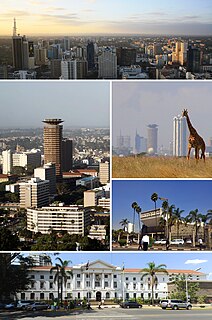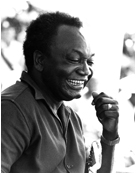 |
|---|
| This article is part of a series on the politics and government of Kenya |
|
| Foreign relations |
Economic schemes |
General elections were held in Kenya in 1952.
 |
|---|
| This article is part of a series on the politics and government of Kenya |
|
| Foreign relations |
Economic schemes |
General elections were held in Kenya in 1952.
The number of European seats in the Legislative Council was increased from 11 to 14, with two new constituencies in the countryside and one in western Nairobi. [1] The number of Indian seats was increased from five to six, although two seats were allotted to Muslims at their request. [1] All but one of the Indian candidates were running on behalf of the East African Indian National Congress, which supported a boycott of the Council in protest at the division of the Indian seats based on religion. [1] The majority Black population was not entitled to vote, and instead six members (an increase from four) were appointed by the Governor from lists drawn up by local governments following hustings. [1]
White people in Kenya or White Kenyans, are those born in or resident in Kenya who descend from Europeans and/or identify themselves as white. There is currently a minor but relatively prominent white community in Kenya, mainly descended from British, but also to a lesser extent Italian and Greek, migrants dating from the colonial period.

The Legislative Council of Kenya (LegCo) was the legislature of Kenya between 1907 and 1963. It was modelled on the Westminster system. It began as a nominated, exclusively European institution and evolved into an electable legislature with universal suffrage. It was succeeded by the National Assembly in 1963.

Nairobi is the capital and the largest city of Kenya. The name comes from the Maasai phrase Enkare Nairobi, which translates to "cool water", a reference to the Nairobi River which flows through the city. The city proper had a population of 3,138,369 in the 2009 census, while the metropolitan area has a population of 6,547,547. The city is popularly referred to as the Green City in the Sun.
| Constituency | Candidate | Votes | % | Notes | |
|---|---|---|---|---|---|
| European seats | |||||
| Aberdare (6 June) | Humprey Slade | 494 | 54.6 | Elected | |
| Thomas Cholmondeley | 410 | 45.4 | |||
| Coast (3 June) | Shirley Victor Cooke | 185 | 50.7 | Re-elected | |
| George Alexander Heath | 119 | 32.6 | |||
| George Bennett Mouseley | 61 | 16.7 | |||
| Kiambu | Wilfrid Havelock | Unopposed | Re-elected | ||
| Mau (30 May) | William Crosskill | 298 | 70.6 | Elected | |
| HE Buzton | 124 | 29.4 | |||
| Mombasa | Cyril Usher | Unopposed | Elected | ||
| Mount Kenya (7 June) | Llewellyn Briggs | 422 | 64.6 | Elected | |
| Thomas Chippindall Colquitt Lewin | 231 | 35.4 | |||
| Nairobi North | Stanley Ghersie | Unopposed | Elected | ||
| Nairobi South (10 June) | Norman Harris | 1,082 | 49.7 | Elected | |
| Derek Erskine | 724 | 33.3 | Defeated | ||
| Leo Eric Vigar | 371 | 17.0 | |||
| Nairobi West (3 June) | Ewart Grogan | 770 | 71.6 | Elected | |
| Jean Remi Martin | 305 | 28.4 | |||
| Nyanza (2 June) | Agnes Shaw | 632 | 66.6 | Elected | |
| Noel Mackintosh Stuart Irwin | 317 | 33.4 | |||
| Rift Valley | Michael Blundell | Unopposed | Re-elected | ||
| Trans Nzoia | Albert George Keyser | Unopposed | Re-elected | ||
| Uasin Gishu | Laurence Maconochie-Welwood | Unopposed | Re-elected | ||
| Ukamba | Dorothy Shaw | Unopposed | Re-elected | ||
| Non-Muslim Indian seats | |||||
| Central (8 June) | Chanan Singh Daulat Ram | 8,410 | 35.6 | Elected | |
| Chunilal Madan | 5,886 | 24.9 | Re-elected | ||
| Dahabhai Travadi | 5,798 | 24.5 | |||
| S G Amin | 2,719 | 11.5 | |||
| K B Shah | 813 | 3.4 | |||
| Eastern (31 May–1 June) | Ambalal Bhailalbhar Patel | 3,874 | 57.6 | Re-elected | |
| Dosalal Ghelabhai Mehta | 2,846 | 42.4 | |||
| Western (4 June) | Jethabhai Somabhai Patel | 3,102 | 50.3 | Elected | |
| Ahluwalia Pritam | 3,065 | 49.7 | Defeated | ||
| Muslim Indian seats | |||||
| East (7–8 June) | Sayed Ghula Hassan Sayed Ali Mohamed Shah | 2,932 | 55.2 | Elected | |
| Mohamed Ali Rana | 2,377 | 44.8 | |||
| West | Ibrahim Nathoo | Unopposed | Re-elected | ||
| Arab seat | |||||
| Colony and Protectorate (4 June) | Mahfood Saleh Mackawi | 465 | 52.0 | Elected | |
| Mohamed Abdulla Shatry | 430 | 48.0 | Defeated | ||
| Source: East Africa and Rhodesia [2] | |||||
The newly elected Council convened for the first time on 12 June. [3]

The Kenya African National Union (KANU) is a Kenyan political party that ruled for nearly 40 years after Kenya's independence from British colonial rule in 1963 until its electoral loss in 2002. It was known as Kenya African Union (KAU) from 1944 to 1952.KAU was banned by the colonial government from 1952 to 1960.It was re-established by James Gichuru in 1960 and renamed to KANU on 14 May 1960 after a merger with Tom Mboya's Kenya Independence Movement.
Elections in South Africa are held for the National Assembly, provincial legislatures and municipal councils. Elections follow a five-year cycle, with national and provincial elections held simultaneously and municipal elections held two years later. The electoral system is based on party-list proportional representation, which means that parties are represented in proportion to their electoral support. For municipal councils there is a mixed-member system in which wards elect individual councillors alongside those named from party lists.

Elections in Kenya take place within the framework of a multi-party democracy and a presidential system. The President, Senate and National Assembly are directly elected by voters, with elections organised by the Independent Electoral and Boundaries Commission (IEBC).
The Senate was the upper house of the Parliament of South Africa between 1910 and its abolition from 1 January 1981, and between 1994 and 1997.

Local government elections took place in England (only) on Thursday 4 May 2006. Polling stations were open between 7:00 and 22:00.

The West Bengal Legislative Assembly is the unicameral legislature of the Indian state of West Bengal. It is Located in the B. B. D. Bagh area of Kolkata (Calcutta)-the Capital of the state. Members of the Legislative assembly are directly elected by the people. The legislative assembly comprises 295 Members of Legislative Assembly, which include 294 members directly elected from single-seat constituencies and one nominated from the Anglo-Indian community. Its term is five years, unless sooner dissolved.

The Tamil Nadu Legislative Assembly alone has powers to legislate laws covering state subjects in the Indian state of Tamil Nadu. It has a strength of 235 members of whom 234 are democratically elected using the First-past-the-post system. The remaining member is nominated as a representative of the Anglo-Indian community. The presiding officer of the Assembly is called the Speaker. The term of the Assembly is five years unless it is dissolved earlier.
Middlesex County Council was the principal local government body in the administrative county of Middlesex, England from 1889 to 1965.

General elections were held in Kenya between 25 September and 2 October 1956, with additional elections in March 1957 for eight African constituencies, the first in which Africans could be elected. The elections in 1956 were open to Europeans and Indians. In the European constituencies the results saw eight Independent Group members and six independents elected.

Ronald Gideon Ngala (1923–1972) was a Kenyan politician who was the leader of the Kenya African Democratic Union political party from its creation in 1960 until its dissolution in 1964.

General elections were held in East Africa Protectorate in March and April 1920, the first elections in the country. The Legislative Council had previously consisted entirely of appointed members. The new Council consisted of 11 elected white members, two appointed members representing the Indian population and one appointed member representing the Arab population, as well as a number of appointees by the Governor. This allowed the Council representative, although not responsible government. The territory became Kenya Colony on 23 July.

General elections were held in Kenya Colony on 2 April 1924. The elections were the first under a new Constitution which saw suffrage extended to Indians and Arabs, who were allotted five and one elected seat in the Legislative Council respectively, alongside the eleven elected seats for the white population, although appointed members were still the majority. Whilst all adult Indian residents were given the right to vote, in the Arab community only men literate in Arabic or Swahili and resident in the country for two years were enfranchised, as the community had requested that women not be given the right to vote. One member was appointed to represent the majority black population.

General elections were held in Kenya Colony in 1934, with the first seats elected on 28 March. Four candidates were returned unopposed in the eleven Europeans constituencies, whilst the remaining seven constituencies were contested by 18 candidates. For the five Indian seats, there were 17 candidates. Voter turnout in the White seats was the highest since elections were introduced. The Council convened for the first time after the election on 24 April.

General elections were held in Kenya Colony between 26 March and 2 April 1938. Three of the eleven white seats in the Legislative Council were uncontested, whilst all Indian seats were contested, and saw more businessmen were elected than politicians. Lady Sidney Farrar became the country's first female Legislative Council member after defeating Conway Harvey in the Nyanza constituency by two votes.

General elections were held in Northern Rhodesia on 20 March 1959, although voting did not take place in two constituencies until 9 April. The United Federal Party (UFP) was expected to win the elections, and did so by taking 13 of the 22 elected seats on the Legislative Council.

General elections were held for the first time in Nyasaland on 15 March 1956.

General elections were held in Kenya in May 1948.

The Kenya Indian Congress (KIC) was a political party in Kenya.
An election to the County Council of London took place on 3 April 1952. The council was elected by First Past the Post with each elector having three votes in the three-member seats. The Labour Party made substantial gains and greatly increased its majority.